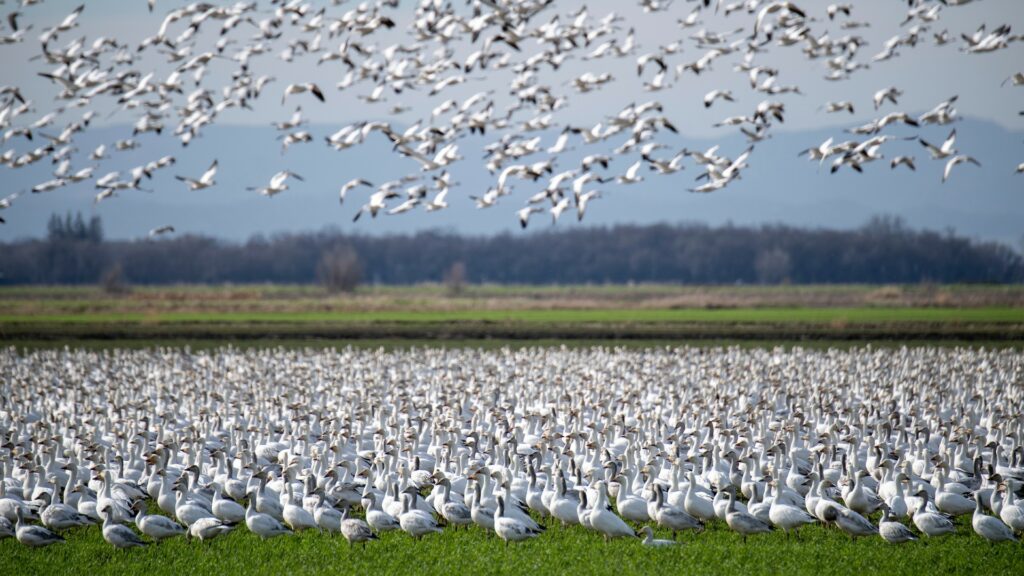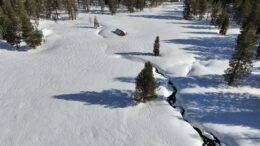The superbloom can be seen from space. California’s wet winter — bolstered by a torrent of atmospheric rivers — has yielded a bumper crop of colorful, knee-high wildflowers cascading across hillsides in the region.
It wasn’t all roses — or purple phacelia — earlier in the year. The state’s heavy winter rains at lower elevations and dozens of feet of snow in the Sierra Nevada mountains took more than 20 lives, cost billions in damages and prompted 47 counties to declare a state of emergency. Many still brace for flooding as one of the largest snowpacks on record melts out of the mountains and rushes downstream.
Other states like Wyoming, Colorado and Utah also received above-average snowpacks, which has helped to ease drought across the West. But for wildlife throughout the region, the rain and snow has been a mixed blessing.
The impacts to wildlife — both positive and negative — vary widely, says Caitlin Roddy, environmental program manager for the North Central region of the California Department of Fish and Wildlife.
The Bad
In many places ungulates suffered significantly.
Wyoming saw deep snowpacks at lower elevations that proved deadly. Mule deer and pronghorn starved to death by the thousands. The Wyoming range mule deer herd, one of the state’s 37 herds, lost half its numbers.
ICYMI: The Wyoming winter was especially severe at low-elevations, where record snow depths persisted into the spring and wildlife suffered because of it. Up in the mountains, it was a different story. https://t.co/ULW7Mv6nKi
— WyoFile (@WyoFile) April 17, 2023
Deer and elk herds in Northern Colorado were also hit hard by the deep snowpack, which made finding food more difficult. That forced the animals to roadways where they could move more easily but were exposed to threats from vehicle collisions.
It was a similar story in northern Utah, where record-breaking snow falls also made it difficult for mule deer to find food, leading to expected losses in one area of 70% of adults and 90% of fawns.
“What you’re seeing in other states with ungulates, we’re expecting the same issues, but we don’t have our data yet to give hard numbers,” says Roddy. California is likely to see lower pronghorn and elk numbers, she says, but deer, which can move to lower elevations where snowpack wasn’t as heavy, should fare okay.
Fewer pronghorn and elk could cause problems in the months and years ahead, including changing the behavior of one their predators: mountain lions.
“When there’s limited forage for the ungulates, then they don’t have a good reproductive year and there’s fewer of them,” she says. “Then the mountain lion population, you’d expect it to decline after that, and you hope that they don’t switch to alternative prey, which is livestock.”
That could lead to more human-mountain lion conflicts.
Other animals could face declines as well.
For bi-state sage grouse, which number only 3,300 as they await Endangered Species Act protections, heavy snows would have made finding food harder. Researchers are concerned the birds may be further imperiled by predators as they undertake showy displays to attract mates while white snow still covers their breeding grounds.
Birds that nest near the ground at high elevations, like white-crowned sparrows, may skip breeding if there’s still too much snow, Ryan Burnett, Sierra Nevada group director at Point Blue Conservation Science, told the Los Angeles Times.
Some people may be surprised to know that the wet winter weather may also yield a worse wildfire season.
“We tend to think if there’s a lot rain it means less fire, but really it’s the opposite – rain means you also see more plant growth overall, and that can increase the fuel load,” says Roddy. “[Those plants are] going to dry out at the tail end of the summer because that’s how our climate works. So it could be a difficult fire year for us.”
The Good
The wet weather certain wasn’t all bad news. For many species, it was a boon.
Populations of native salmon, steelhead and trout — previously diminished by low river flows from drought and diversions for human use — will now find revived creeks that provide good spawning habitat. The higher river flows can make it easier for them to migrate. And when rivers wash up onto floodplains, nutrients that help fish develop and thrive are returned to the water.
Migratory birds that travel the Pacific Flyway will benefit from more water in wildlife refuges and flooded rice fields. This will help reduce disease outbreaks that occur when the birds are forced into small areas with limited water.

The wet winter will also result in an increase in vegetation this spring and summer that Sierra Nevada bighorn sheep enjoy, helping them to boost fat reserves for next winter. Unlike their counterparts in the northern part of the state, deer herds in southern Utah are benefitting from greener vegetation and more moisture, with experts expecting a higher-than-normal survival rate.
Lots of rain also gave blue oaks, a tree found only in California, a needed reprieve, says Angela Moskow of the California Wildlife Foundation.
“The drought was hard on California’s oaks, and so too has been the shifting climate — the intense heat combined with dry weather is really stressing some of them,” she says. “For the oaks, we’re happy in general to have the rains.”
That will help the trees and many others. Some 330 vertebrate species in the state depend on oaks, and many more insects and other plants are associated with the woodlands.
But long-term drought and higher temperatures have also taken a toll on other forests. Roddy cautions that when it comes to the Sierra Nevada’s pine forests, much more precipitation is needed.
“For the pine forests, I don’t know that a single wet year will make that much of a difference,” she says. “If this is the beginning of this long-term drought that we’re in lessening and we end up having more average or above-average water years, then that would be a good thing for the forest.”
It’s a reminder that for many species, it will take months or years to understand the full effect of this winter’s weather — and the bigger changes ahead. Not all wildlife will be able to quickly adapt to extreme weather events amplified by climate change, not to mention long-term changes in temperature and precipitation.
That’s not an invitation to intervene. “Just because it’s an extreme year, it doesn’t mean the wildlife need you to feed them,” says Roddy. “Give them a chance to be wild.”
Plants and animals do need our help in curbing climate change, though — and not just in the United States, of course. As plants and animals face climate-induced weather extremes across the globe, researchers say there’s a key thing we can do to help beyond the work of rapidly limiting the burning of greenhouse gasses: protect and restore habitat.
“The one fail-safe option for helping species cope with extreme events is to retain intact habitats, as these are the places where species are most resilient to extreme events,” Australian scientists Sean Maxwell and James Watson wrote in The Conversation. “Where intact habitat protection is not possible, restoring land or seascapes can also help species to adapt to extreme events.”
![]()
Previously in The Revelator:
As Extreme Weather Events Increase, What Are the Risks to Wildlife?


